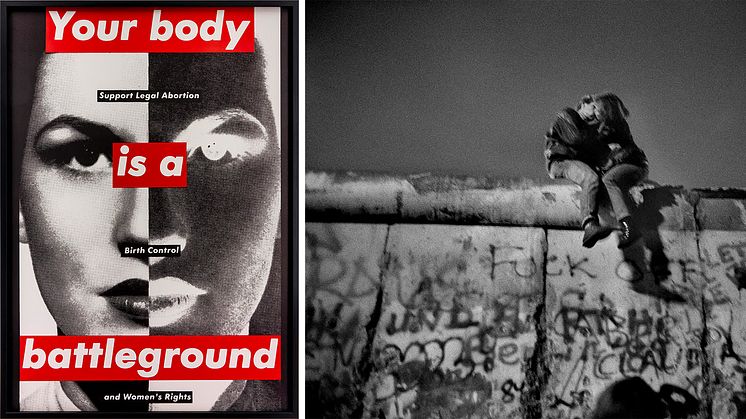
Press release -
Exhibition about 1989 at Nationalmuseum this autumn
This autumn, Nationalmuseum features an exhibition on one of the most dramatic moments in history – the fall of the Berlin Wall in 1989. The exhibition, which opens on 5 September, takes a broad look at what happened within the visual culture during the upheavals of 1989. Global outlooks, Swedish perspectives and high politics meet mundane everyday life in an array of documentary photography, portraits, posters, videos and designs.
The Berlin Wall fell on 9 November 1989. The Cold War came to an end and the struggle between liberal capitalism and communism seemed to be over. Eastern Europe was not, however, the only place on earth shaken by political drama. The South African apartheid regime collapsed and on the Tiananmen Square in China, student demonstrations ended with a massacre.
The collapse of communism in Eastern Europe is often seen as the start of global capitalism. Globalisation did not, however, occur only in the field of economics. In 1989, the concept of a World Wide Web was coined at the same time as the first pocket sized mobile telephone was launched. The third edition of the Havana Biennial in 1989 is often described as a milestone in the development towards a globalisation of contemporary art. The late 1980s was also marked by a global tragedy. AIDS, spreading like an epidemic across the world, became a much feared disease.
At the turn of the decades of the 80s and 90s, conflicts about freedom of speech, religious and ethical values flared up in many places. The Iranian leader Khomeini issued a death sentence against Salman Rushdie whilst images by Robert Mapplethorpe caused outrage and protests in the USA. In Sweden, charges were brought against Horst Schröder, publisher of the adult comics magazine ‘POX’, for illegal depictions of violence.
Against this backdrop of social development and political drama, the 1989 exhibition dives into the scene of visual culture at the turn of the 80s and 90s. Global outlooks and Swedish perspectives alternate. High politics meet mundane everyday life – illustrated in the form of political resistance posters from Hungary and former Czechoslovakia, pictures of Mexican immigrants on the border to the United States, modernist furniture designs, abortion rights activism, kitsch aesthetics, music videos and restaurant interiors. Conceptually, the exhibition revolves around notions such as freedom versus lack of freedom, borders versus borderless.
The exhibition includes documentary photography, portraits, posters, videos and designs by artists, photographers and designers such as Richard Avedon, Ron Arad, Cecilia Edefalk, Nan Goldin, Willliam Kentridge, Barbara Kruger, Boris Mikhailov, Tracey Moffatt, Ingrid Orfali, Ingegerd Råman, Philippe Starck, Lars Tunbjörk, Pia Wallén and Andres Serrano. A book with texts by Per Hedström, Anna Charlotta Gunnarson, Kalle Lind, Estelle af Malmborg, Sara Kristoffersson and Andreas Johansson Heinö is also being launched in connection with the exhibition.
The 1989 – Culture and Politics exhibition will run from 5 September 2019 until 12 January 2020. The exhibition is curated by Per Hedström, Director of Exhibitions at the Nationalmuseum, Lena Eriksson, Head of Education at the Nationalmuseum, Estelle af Malmborg, Independent Curator and Sara Kristoffersson, Professor of Design History.
Press preview
The exhibition will open to press and media on 4 September from 10 a.m. until 12 noon. Access is via the museum’s main entrance from 10 a.m. onwards. Registration is by e-mail to press@nationalmuseum.se no later than 2 September. Please note that only accredited press and media representatives may attend.
More information
Hanna Tottmar, Press Officer, press@nationalmuseum.se, +46 (0)8 5195 4400
Categories
Nationalmuseum is Sweden’s museum of art and design. The collections comprise older paintings, sculpture, drawings and graphic art, and applied art and design up to the present day. The museum building has currently been renovated and reopened in autumn 2018. Nationalmuseum has partnerships with Svenska Dagbladet, Bank of America Merrill Lynch, The Wineagency and the Grand Hôtel Stockholm.

